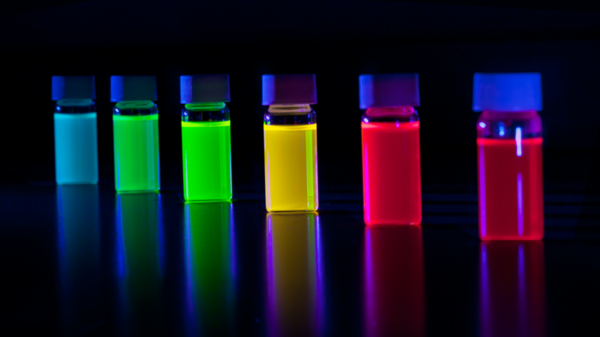The Full Width Half Maximum of Quantum Dots
Display technologies have evolved. It is now feasible to achieve infinite contrast ratios using efficient organic light-emitting diodes (OLEDs) with peak brightness measurements of just 540 nits. Quantum dot technology has eclipsed last generation color spaces to reach as much as 90% coverage of Rec. 2020, offering the most vibrant color representation currently attainable. However, these revolutionary technologies still rely on relatively basic optical principles.

The innovative Rec. 2020 color space represents a spectral increase of as much as 72% on Rec.709/sRGB but achieving high color purity across this demanding spectrum still requires the mixture of primary colors; red, green, and blue (RGB). Quantum dots are unparalleled in their ability to reproduce true colors, boasting coverage of as much as 93% of nature’s visible spectra. This is due to the fine tunability of quantum dot nanocrystals, which can be engineered to produce spectrally narrow primary colors within pixels.
The optical bandwidth of a light source is measured by a principle known as the full width at half maximum (FWHM).
What is Full Width at Half Maximum?
The term FWHM refers to the width of an optical signal at half its maximum intensity. This measure gives the bandwidth of a light source operating at 50% capacity. It is also an important property for determining color representation after light has been modulated by color filters and polarizing layers.
The emissive properties of quantum dots are both chemistry and size dependent. Typically, larger quantum dots (~7 nm) generate the longest wavelengths of light (~640 nm) at peak intensity. However, quantum dots usually exhibit an emissive function in the shape of a Gaussian curve. Lower intensities may result in broader spectral bandwidths and less pure color representation onscreen.
To determine the FWHM, the difference must be calculated between the low and high wavelength points at half the maximum spectral intensity. Narrower bandwidths translate to purer colors with higher levels of efficiency and vice versa.
Avantama’s cesium lead halide perovskite quantum dots have attracted significant attention due to their FWHM as low as 20 nm for green quantum dots with an emissive wavelength of 530 nm. Even comparatively large red quantum dots with a metal halide chemical structure boast a FWHM of just 35 nm, representing the purest possible primary colors within pixels onscreen. This enables images to be generated by extremely pure emission spectra, supporting the widest possible color gamut currently available.
Quantum Dots from Avantama
Avantama is the world’s leading supplier of Perovskite quantum dots for electronics and display applications. We have developed a proprietary method for solution processing various printed electronics, with a bespoke formulation service for nanoparticle dispersions.
If you would like to learn more about the capacities of quantum dot display technologies, try: Comparing the Peak Brightness of OLED and QD Displays. Or, contact us for any more information.